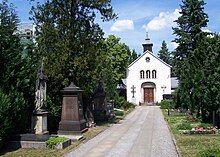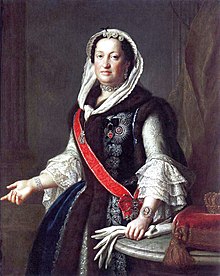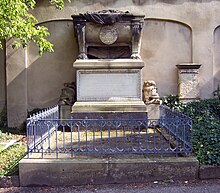Old Catholic Cemetery (Dresden)
The Old Catholic Cemetery (also known as the Inner Catholic Cemetery ) is one of the oldest still existing burial places in Dresden and at the time of its inauguration in 1724 was the first Catholic cemetery in the city after the Reformation. Due to numerous baroque , rococo and classicism tombs , it is one of the most important cemeteries in the Dresden area in terms of cultural history. The complex is one of the cultural monuments of Dresden's Friedrichstadt .
In particular, the Old Catholic Cemetery stands out from the New Catholic Cemetery , which is also located in Dresden's Friedrichstadt .
history
Catholic cemeteries, like Jewish cemeteries , were still forbidden in the strictly Protestant Dresden in the 17th century. When August the Strong converted to the Catholic Church in the trade for the Polish royal crown in 1697, the influx of Catholic artists, scholars and officials to the capital of Saxony grew in the following years. Equally politically motivated was the marriage of Prince Elector Friedrich August II. To the Austrian Archduchess Maria Josepha in 1719, which August the Strong himself had promoted. Through a connection with Austria he hoped, among other things, to win allies against the increasingly stronger Prussians . Maria Josepha had been brought up strictly Catholic and had her marriage contract "promise that all of her male and female servants should be buried in their own churchyard". Before that, Catholics had to be buried either in the St. Marienstern monastery in Lusatia or in Bohemia. If this was not possible with financial means, they could be buried in Protestant cemeteries contrary to their beliefs.
On October 2, 1720, August the Strong gave the order to lay out the first Catholic cemetery in Dresden. In order to avoid conflicts with the Protestant population, a place outside the residential city in what was then the Kammergut Ostra was chosen. The suburb of Dresden had only been founded in 1670 and was one of the sparsely populated and inviting properties of the elector. Catholics could only be buried in the new cemetery under certain conditions. They either had to come from the court of Maria Josepha or belong to her servants. Deaths had to be reported to the city council before the funeral, and the funerals themselves had to take place in silence. At the same time, August the Strong forbade making changes to the cemetery or building a chapel . Crypts were forbidden, "which at the time included a reduction in the cemetery in question". The cemetery was subordinate to August the Strong himself, who despite his Catholic faith had remained head of the Protestant regional church.
It was not until 1723 that August the Strong issued two letters of favor in which he stipulated that, in contrast to funerals in Protestant cemeteries, no funeral fees had to be paid to Protestant clergymen for funerals in the cemetery. Catholics who belonged to the royal household of the king and the elector were also allowed to be buried in the cemetery, but had to pay the fee. The “chosen” Catholics were checked using a certified directory that listed all Catholics at the Saxon court and that had to be submitted to the Evangelical Secret Council every year.
The first burial took place on February 16, 1724, when the Italian actor Johann Carl Philipp Molteno was buried. In the same year 27 more burials followed. Under Friedrich August II. , On September 9, 1738, all Catholics without exception received permission to be buried in the Catholic cemetery. In addition to residents of Dresden, Catholics from “Neustadt, Leipzig and other neighboring places” were also allowed to find their final resting place in Dresden. As a result, the Old Catholic Cemetery soon became too small and therefore expanded in 1740 and 1742. The ordinance of Augustus the Strong to leave the cemetery unchanged for all time had already been repealed with the royal directive from 1738. In 1842, Bishop Franz Laurenz Mauermann made a third expansion of the cemetery to its present size. In the same year, the Michael's Chapel, which was consecrated on September 7, 1842, was built on the new, narrower land. In 1914 it received an extension in which Balthasar Permoser's crucifixion group was set up, and a new portal with the relief of Christ Carrying the Cross by Matthias Corr . There are two memorial crosses for members of the Wettin royal family next to the entrance .
Gravesites
Funerary art
In the 18th and 19th centuries, cemeteries, including the Old Catholic Cemetery, “became places where sculptors preferred to show themselves. A real passion for stately grave monuments broke out. ” Franz Pettrich, among others, worked at the Old Catholic Cemetery . Together with Traugott Leberecht Pochmann (1762-1830) he created the grave monument of his teacher Giovanni Battista Casanova as well as the grave relief for Bishop Johann Alois Schneider and the grave figure for Maria Therese von Dressler and Scharfenstein. His "undoubtedly most sensitive work" is the tomb for his two deceased wives. It shows a resting woman on a sarcophagus , holding two poppy seed capsules in her hand, equating death to eternal sleep. In front of the sarcophagus is Pettrich's own simple grave.
Gerhard von Kügelgen's simple tombstone became famous and was immortalized by Caspar David Friedrich in his painting Kügelgen's tombstone from 1822 . The original stone was replaced by a copy after the Second World War . The grave of Carl Maria von Weber , who was only transferred to Dresden in 1844 at the instigation of Richard Wagner , comes from Gottfried Semper , the builder of the Dresden Semperoper .
Balthasar Permoser , one of the most important baroque sculptors, also found his final resting place in the Old Catholic Cemetery. At the age of 80 he made his own grave decorations. The large crucifixion group that originally adorned his grave was first restored in 1888 and finally moved to the chapel due to weather conditions, which was annexed for this purpose in 1914. The figure next to Permoser's grave, which adorns the burial site of an unknown person, is now regarded as a work by Permoser.
The grave of Major General Baron Georg von O'Byrn (1864–1942), whose portrait bust on the tombstone is by Georg Wrba , is also of artistic interest . The portrait medallions of the graves of Maciej Wodziński and Countess Josepha Agnes Puchalska were made by Ernst Rietschel . The writer Otto Rudert also referred to the Old Catholic Cemetery as a "funerary island" due to the numerous artistically valuable tombs.
The relief Good Shepherd in the center of the Priest's Crypt I was created by the sculptor Otto Zirnbauer , who worked in Dresden from 1935 to 1942.
Personalities who have found their final resting place here
The graves of Catholic visual artists, composers, singers and writers are located in the Old Catholic Cemetery. Two crypts for clergy are a specialty. The urns of clergy Alois Andritzki , Aloys Scholze and Bernhard Wensch, who died in the Dachau concentration camp , were buried in the Priest's Crypt I, which is decorated with a relief by Otto Zirnbauer (1903–1970) . The urns of these three priests were transferred to the Catholic Court Church in a procession in 2011 as part of Andritzki's beatification process . Clergymen killed in the air raid on Dresden also found their final resting place in the first priestly crypt. In the Priest Crypt II, the Christ relief of which is by Hugo Peters , there are graves of clergymen who died after 1945. On a larger burial area behind the chapel are numerous graves of members of the Congregation of the Sisters of St. Elisabeth , who have been working in Dresden since 1860. All graves look alike and show white writing on a black background with a simple white cross.
Numerous Italian artists, but also entrepreneurs, found their final resting place in the cemetery. Some of them had come to Dresden under Augustus the Strong. Many of them were involved in the construction of the Catholic Court Church from 1738 (see " Italian village "). The French Zacharias Longuelune , who provided designs for the court church, found his final resting place in the cemetery, as did the Italian Lorenzo Mattielli , who created 78 larger-than-life figures for the cathedral . The neoclassical tomb of the married couple Giovanni Ercole Samuele Torniamenti († January 12, 1890), owners of the Café Reale on the Brühlsche Terrasse , and their son, the painter Carlo Torniamenti , who died early , as well as the graves of the painter Ermenegildo Antonio Donadini and his son Ermenegildo Carlo Donadini (1876–1955) are in the Old Catholic Cemetery.
Of the originally around 120 graves of Polish Catholics, around 37 have been preserved in the cemetery. These are graves of Poles, which on the one hand already belonged to the Saxon court under August the Strong, and on the other hand came to Dresden as emigrants only after the failure of the November uprising in 1830.
Graves
- Albrecht Joseph von Sachsen (1934–2012), historian
- Alois Andritzki (1914–1943), chaplain, urn 2011 transferred to the Catholic Court Church
- Franz Bernert (1811–1890), bishop and apostolic vicar in the Saxon hereditary lands
- Theodor Blumer (1881–1964), composer and conductor
- Rudolf Bockelmann (1892–1958), chamber singer
- Bartolomeo Bosco (1793–1863), magician
- Kazimierz Brodziński (1791–1835), poet
- Giovanni Battista Casanova (1730–1795), sculptor
- Irene von Chavanne (1863–1938), singer
- Eberhard Deutschmann (1926–2005), civil engineer
- Joseph Dittrich (1794-1853), bishop and apostolic vicar in the Saxon hereditary lands
- Ermenegildo Antonio Donadini (1847–1936), painter
- Ermenegildo Carlo Donadini (1876–1955), painter and restorer
- Anton Dreyssig (1774–1815), musician
- Othmar Faber (1927–2008), clergyman
- Leonhard Fanto (1874–1940), painter
- Ludwig Forwerk (1816–1875), bishop and apostolic vicar in the Saxon hereditary lands
- Johann Christian Götze (1692–1749), librarian
- Dieter Grande (1930–2016), clergyman and publicist
- Ernst Julius Hähnel (1811-1891), sculptor (replica, installed in 2016)
- Joseph Herrmann (1800–1869), sculptor
- Johann Centurius von Hoffmannsegg (1766–1849), botanist
- Ernst Hottenroth (1872–1908), sculptor
- Johann Georg Chevalier de Saxe (1704–1774), illegitimate son of Augustus the Strong
- Auguste Charlotte von Kielmannsegge (1777–1863), spy
- Hadwig Klemperer (1926–2010), philologist and editor
- Karl August Krebs (1804–1880), tombstone: Carl August Miedke called Krebs , Hofkapellmeister
- Mary Krebs-Brenning (1851-1900), pianist
- Aloyse Krebs-Michalesi (1824–1904), opera singer
- Edmund Kretschmer (1830–1908), composer
- Gerhard von Kügelgen (1772–1820), painter
- Franziska Martloff (1788–1865), singer and actress
- Marvelli Jr. (1932–2008), magician
- Franz Laurenz Mauermann (1780–1845), bishop and apostolic vicar in the Saxon hereditary lands
- Klaus Mertens (1931–2014), architectural scientist and building researcher
- Karl Borromeo von Miltitz (1781–1845), poet and composer
- George von O'Byrn (1864–1942), major general
- Alexander von Oer (1841-1896), civil engineer
- Theobald von Oer (1807–1885), painter
- Gustaw Olizar (1798–1865), poet
- Ferdinand Pauwels (1830–1904), painter
- Balthasar Permoser (1651–1732), sculptor
- Franz Pettrich (1770–1844), sculptor
- Friedrich von Schlegel (1772–1829), philosopher and poet
- Johann Alois Schneider (1752-1818), Catholic bishop
- Aloys Scholze (1893–1942), pastor, urn 2011 transferred to the Catholic Court Church
- Franz Anton Schubert (1768–1824), composer
- Franz Seydelmann (1748–1806), composer
- Karl Sontag (1828–1900), actor
- Kurt Striegler (1886–1958), composer
- Joseph Tichatschek (1807–1886), opera singer
- Carl Ulbricht (1904–1981), politician
- Harald Walther (1929–2013), paleobotanist
- Carl Maria von Weber (1786–1826), composer
- Max Maria von Weber (1822–1881), railway engineer
- Hermann Joseph Weisbender (1922–2001), Vicar General
- Bernhard Wensch (1908–1942), youth pastor, urn 2011 transferred to the Catholic Court Church
- Elżbieta Zimmermann (1943–2007), promoter of German-Polish reconciliation
Not preserved graves and memorial stones
Since the cemetery was founded, graves have been dismantled, gravestones have been destroyed or lost. Some of these tombstones could be restored, and others were replaced by memorial stones. This includes the memorial stone for the sculptor Lorenzo Mattielli , which the sculptor Christian Hempel created in 2001. With its convex end it forms the counterpart to the memorial stone for the composer Jan Dismas Zelenka , which Christian Sieg created in 1996 and whose end piece has a concave quarter sphere. The gravestones of the court musicians Silvius Leopold Weiss and Francesco Maria Cattaneo were also lost and were replaced by a memorial stele. A plaque commemorates the translator Dorothea Tieck , daughter of the writer Ludwig Tieck .
Graves that have not been preserved but have not been replaced by a memorial stone include those of:
- Luigi Bassi (1766-1825), singer
- François Coudray (1678–1727), sculptor
-
Anton Bernhard Fürstenau (1792-1852) and his son Moritz Fürstenau (1824-1889), flautists
- A memorial stone for Moritz Fürstenau was inaugurated on May 6, 2018 on the original grave site.
- Friedrich August Kummer (1797–1879), cellist
- Zacharias Longuelune (1669–1748), Baroque architect
- Alexander Jakob Lubomirski (1695–1772), General
- Johann Aloys Miksch (1765–1845), singer
- Joseph Schuster (1748–1812), composer
- Thaddäus Ignatius Wiskotschill (1753–1795), sculptor
There are also memorial crosses for members of the Wettin royal family in the Old Catholic Cemetery . In front of the chapel are the memorial crosses for King Johann von Sachsen and his wife Amalie Auguste von Bayern (left, dark cross) and his sister, the comedian Amalie von Sachsen , who is commemorated with the white cross to the right of the chapel entrance. Further memorial crosses in the cemetery remember Maria Kunigunde of Saxony and Johann Georg of Saxony , brother of the last Saxon king Friedrich August III. Most of the graves of members of the Wettin royal family since 1700 are now in the crypt of the Catholic Court Church .
literature
- Christoph Pötzsch : Fates in Dresden's Old Catholic Cemetery . Tauchaer Verlag, Taucha 2004, ISBN 3-89772-078-7 .
- Gudrun Schlechte: The Old Catholic Cemetery in Friedrichstadt in Dresden . Hille, Dresden 2004, ISBN 3-932858-73-5 .
- Marion Stein: Cemeteries in Dresden . Verlag der Kunst, Dresden 2000, ISBN 90-5705-130-3 , pp. 30-39.
Web links
- The history of the cemetery
- Where they rest - Famous graves in historical cemeteries in Germany: Old Catholic Cemetery
- https://www.stadtwikidd.de/wiki/Alter_Katholischer_Friedhof
Individual evidence
- ↑ This excludes church cemeteries, which today belong to Dresden in the course of incorporation and which are partly significantly older.
- ^ Johann Christian Hasche: Diplomatic history of Dresden . Part 1, together with the document book. Self-published, Dresden 1816, p. 677f.
- ^ Marion Stein: Cemeteries in Dresden . Verlag der Kunst, Dresden 2000, p. 31.
- ↑ Stein, p. 33.
- ↑ Hasche, pp. 691f.
- ↑ Benjamin Gottfried Weinart : Topographical history of the city of Dresden and the areas around it . Hilscher, Dresden 1777, p. 210.
- ^ Gudrun Schlechte: The old Catholic cemetery in Friedrichstadt in Dresden . Hille, Dresden 2004, p. 10.
- ^ Paul Franz Saft: The rebuilding of the Catholic Church in Saxony in the 18th century . St. Benno Verlag, Leipzig 1961, p. 75.
- ^ Cornelius Gurlitt : Dresden. The culture . Marquardt, Berlin 1907, p. 45.
- ↑ Stein, p. 36.
- ↑ Bad, p. 41.
- ^ Otto Rudert: Old Dresden cemeteries . Heinrich, Dresden 1931.
- ^ Folke Stimmel et al .: Stadtlexikon Dresden . Verlag der Kunst, Dresden 1994, p. 41.
- ↑ Compare the footnote in the catalog of the Library of Congress: "The indication '1728' for the year of birth on the gravestone ... is based on incorrect information ..."
- ↑ Guided tour of the cemetery with a special tribute to the newly designed grave of Moritz Fürstenau. on Sunday, May 6th, with Christoph Pötzsch . Diocese of Dresden-Meißen , May 2, 2018, accessed on November 11, 2018 .
- ↑ Cf. Gudrun Schlechte (Hrsg.): The crypt of the Saxon royal house Wettin in the cathedral Sankt Trinitatis - Hofkirche zu Dresden . Janos Stekovics, Dößel 2004.
Coordinates: 51 ° 3 '37.2 " N , 13 ° 43' 9.5" E











